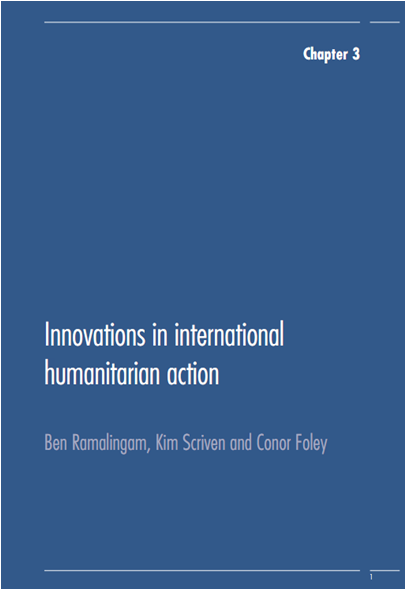The blog post below was published here by Kim Scriven of the Active Learning Network for Accountability and Performance in Humanitarian Action (ALNAP). ALNAP, as a unique sector-wide active learning membership network, is dedicated to improving the quality and accountability of humanitarian action, by sharing lessons, identifying common problems and, where appropriate, building consensus on approaches. ALNAP has a specific initiative on humanitarian innovation. You can read more about it here and be sure to download their report 2009 study.
_______________________________________________
By: Kim Scriven –
I spent a fascinating day on Tuesday facilitating a workshop on Supporting Innovation in Humanitarian Organisations. The ALNAP workshop, hosted by World Vision International in Geneva, built on research ALNAP has undertaken in recent years, and used this as a basis to focus on the challenges and opportunities of innovation for humanitarian agencies.
We in ALNAP have long been making the case that innovation can lead to improved humanitarian performance, and it is pleasing to see it firmly on the agenda for humanitarian actors. But supporting innovation in principle is very different from delivering innovations in practice – particularly for large operational agencies whose primary concern must always be their ‘bread and butter work’ delivering aid in difficult contexts.
I’m also aware of the specific challenges facing operational agencies seeking to promote innovation. The 2009 ALNAP Study identified that, as agencies have grown over recent years, the spaces for innovation have shrunk, and the sector has seen a growing conservative streak.
Most of those participating in the workshop recognised this picture, although many organisations are increasingly open to the potential opportunities for new technologies (particularly information and communication technologies) to improve humanitarian operations.
The workshop explored case studies and approaches to how these challenges can be overcome. There was particular interest from the group in what new light an innovation perspective could bring to some intractable problems which continue to face humanitarian agencies, for example beneficiary participation, the use of evidence in decision making, and the challenges of effective leadership.
Despite their complexity and unpredictability, successful innovation processes often include the following five key elements, which were used to structure discussions over the day:
- Recognition of a problem, a challenge, or an obstacle to be overcome; with a corresponding opportunity for innovation.
- Invention of a solution, or an idea, which helps to address the problem or seize the opportunity.
- Development of the innovation by creating practical, actionable plans and guidelines.
- Implementation of the innovation to produce real instances of changed practice, often initially using pilots and then scaling up promising innovations.
- Diffusion of the innovation leading to its wider adoption, outside the original setting. This might include various formal and informal communications channels, and may involve the original innovation being continually developed and refined.
We were lucky enough to have contributions from individuals who have been instrumental in making humanitarian innovations happen in the real world. Dr Caetano Dorea from Université Laval outlined his work with Oxfam GB to develop and test innovative water filtration technologies while Otto Farkas, from World Vision Canada, discussed the challenges of scaling up and diffusing innovation, with particular reference to his work on Last Mile Mobile Solutions – using mobile technologies to streamline the distribution of aid.
In addition to this, participants worked through a number of exercises that we were piloting, designed to help unpack the innovation process and stimulate discussion around the organisational capacities, collaborative relationships and organisational culture which all need to be aligned for innovations to flourish. We’ll continue to develop and refine these tools and find ways to share these across ALNAP Member agencies.
I’m more aware than ever that promoting innovation within humanitarian agencies involves a difficult balancing act, and a number of issues arose over the course of the day:
- A proactive and strategic approach is needed which must recognise that innovation is different from other organisational functions, particularly the diverse and novel collaborations from which many innovations stem. Creating a bureaucracy around innovation is a sure-fire way to stifle it.
- In the same vein, the group recognised that innovation is taking place all the time and systems need to capture and promote ideas so they can be further developed and tested, but these systems will fail unless they embrace the unpredictability and serendipity inherent to innovation.
- It was also recognised that the diffusion of promising innovations is neither simple nor certain, and agencies must accept that for ideas to run their course, they may need to stray from the organisation’s control. As Otto pointed out ‘you have to lose it to keep it’.
- Finally, the relationship between innovation and risk was returned to throughout the day. Finding safe spaces for experimentation was seen as essential for innovative yet principled humanitarian response, and Caetano’s presentation set out a practical example of testing water filtration technologies in safe spaces prior to emergency roll- out. Unsurprisingly, questions remained – particularly the relationship between individual and organisational risk – and the subject is one we will doubtless return to again.
For us in the secretariat, it was great to be able to engage with those grappling with these problems every day, and it was good to see a number of ALNAP Members are working proactively on structures and strategies to support innovation. Participants were keen to continue to share ideas and experiences, and to this end ALNAP will work to establish a simple online Community of Practice around the management of innovation. We’d also be fascinated to hear other examples of how organisations have prioritised spaces for innovation, and the ways in which this has helped them find new solutions to the challenges facing humanitarian assistance.



